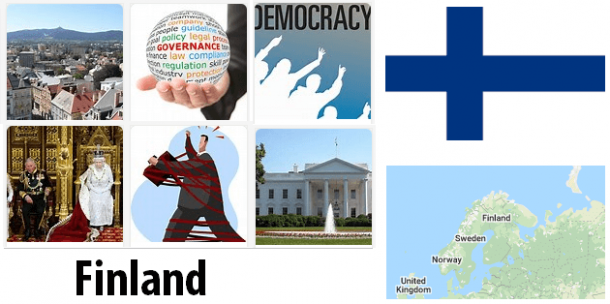Finland Government and Politics
1809 Russian Colony and Beginning Industrialization

In 1809, Finland became a major county within the Russian Empire, although it was allowed to retain parliament, the army and a judiciary. These rights were defended through civil disobedience to the changing Russian governors. In 1889 the Finnish Social Democracy was formed, which from then on played a central role in Finnish political life. The presence of Lenin and other Russian Bolsheviks in exile helped to strengthen the party.
The economic foundations of a Finnish nation were created during the great industrial development that started the economic boom after 1896. The different parts of the country were now finally linked through the emergence of national markets. This was at the same time the basis for the formation of the nationwide labor movement, and it was not until the turn of the century that an actual class of industrial workers emerged.
In 1899, for the first time, the working class emerged as an independent class by rejecting the bourgeois demand for “citizen peace”. The working class had been organized under a bourgeois leadership from the 1880’s, but now detached from it. In 1903, the Labor Party adopted a socialist program and began fighting for the right to vote. The revolutionary events in Russia in 1905-1906 paved the way for a major strike that led to the formation of a one-chamber parliament with universal suffrage – including for women. Finland thus became the third country in the world to give women the right to vote. In 1907 the proletariat sent 80 representatives to a parliament with a total of 200 seats, and in 1916 they obtained an absolute majority with 103 seats.
It was the craftsmen and later also the industrial workers who led the Labor Party. But the party also had a large voter base in the countryside. It consisted of various groups from the village proletariat. The proletariat in the countryside was very difficult to organize directly because of the personal and social ties between it and the peasants. It could only happen indirectly with the help of the Labor Party.
But the industrial workers also had poor conditions for professional organization. Most industrial plants were geographically dispersed, with few industrial centers, and many factories were the only ones in their local area. The low technological level and the large overpopulation in the countryside also helped to reduce the competition for labor. The trade union movement was long dominated by the artisans, and most industrial worker groups first formed trade unions after the big strike. It was not until 1907 that the trade union organization was formed. The advancement of the Labor Party and the boom in these years led to collective agreements being reached. But from 1908 there was a decline in the old conditions. The result was largely the same as in agriculture: The job-seekers neither needed nor were able to change the social conditions of the industry.
The bourgeois had probably been forced to accept significant formal changes in the political system, but the content remained the same. There were several reasons why a democratic political practice did not emerge. The government continued to depend on the emperor. There was no question of introducing parliamentarism. The Russian ruler diligently took advantage of the right to dissolve parliament, and his government withdrew the enactment of laws passed by parliament in length. These were conditions that did not depend on the Finns. But the bourgeois politicians did not fail to use these constitutional “funds” against the Labor Party. Especially on social issues, the perception of the right and left forces was so far apart that no consensus could be reached on any significant points. The lack of results in such cases was also compounded by the fact that the social groups that were not directly involved in the contradictions between the workers and the buyers were so few.
Country data
Area: 338,435 km2 (world rank: 64)
Residents: 5,511,000
Population density: 16 per km2 (as of 2017, world rank: 115)
Capital: Helsinki / Helsingfors
Official languages: Finnish, Swedish
Gross domestic product: 223.5 billion euros; Real growth: 2.6%
Gross national product (GNP, per resident and year): 44,580 US$
Currency: 1 euro (euro) = 100 cents
Embassy
Rauchstr. 1, 10787 Berlin
Telephone 030 505030,
Fax 030 50503333
www.finnland.de
Government
Head of State: Sauli Niinistö, Head of Government: Juha Petri Sipilä, Outside: Timo Juhani Soini
National holiday: 6.12.
Administrative division
6 administrative districts: Åland, Lapland, Oulu, Eastern Finland, Southern Finland, Western Finland; 19 regions
State and form of government
Constitution of 2000
Republic
Parliament (Eduskunta / Riksdag) with 200 members, election every 4 years
Direct election of the head of state every 6 years (one-time re-election)
Suffrage from 18 years of age
Population of: Finns, last census 2010: 5,375. 276 residents
90% Finns, 5% Finland-Sweden, 5% others, among others; approx. 1800 Sámi (Sami), 800 Finland-Tatars Proportion of foreigners 2017: 4.4%
Cities (with population): Mariehamn as of 2014: 13,638 residents.
Religions: 73% Lutherans, 1% Orthodox, other Protestants, Catholics, Muslims, Jews and others; 24% without religion (as of 2006)
Languages: Finnish, Swedish; Recognized minority languages: Inari Sami, North Sami, Skolt Sami, Karelian, Romani, Tatar, Yiddish, Russian
Employed by economic sector:
Agriculture. 4%, industry 22%, business 74% (2017)
unemployment (in% of all economically active persons)
2017: 8.6%
Inflation rate (in%): 2017: 0.8%
Foreign trade: import: 62.1 billion euros (2017); Export: 60.1 billion euros (2017)



